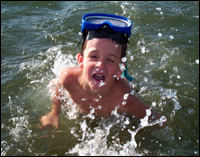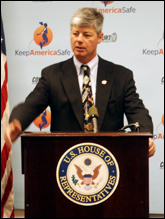Like clean water? Then you’ll love Rep. Bart Stupak.

Swimming in sewage just isn’t this fun.
For the last year, Stupak has been fighting a U.S. EPA proposal that would allow inadequately treated sewage to be “blended” with fully treated waste during rain and snow events. The messy mix would then be released into the nation’s rivers, lakes, and coastal waters. If blending is permitted, Stupak warns, people will get sick, beaches will close, and tourism and fishing will suffer. Not only that, taxpayers will bear the cost of cleanup down the road.
“It doesn’t make sense,” the Michigan Democrat says. He compares it to a questionable cup of water: “Three-fourths of it will be clean, but one-fourth of it is going to be dirty. But the whole glass isn’t dirty; therefore, it’s all right to consume.”
Blending is currently allowed as an exception during extreme events like hurricanes, but is not practiced regularly across the country. The method bypasses the second and most important step in the water-treatment process — the step that kills bacteria, viruses, and pathogens known to cause infectious disease. Such bypasses, prohibited under the Clean Water Act under all but the most outstanding circumstances, would now be allowed in every “wet-weather” event.
Last week, in a bid to block the EPA from implementing that policy, Stupak introduced the Save Our Waters From Sewage Act in the House with cosponsors Mark Steven Kirk (R-Ill.), Frank Pallone Jr. (D-N.J.), and E. Clay Shaw Jr. (R-Fla.). The bill comes on the heels of a late-February letter of concern [PDF] sent to the EPA and signed by 135 House members.

Bart Stupak.
The EPA says it is simply responding to requests by municipalities and sewage treatment operators for a national policy. Under the Clean Water Act, any municipality or industrial operation that discharges wastewater must have a permit that establishes water-quality standards for the final product. Trouble is, some permit writers said blending was prohibited under the act, while others said it was legal. The result was an erratic enforcement policy.
“We’re interpreting existing law and existing regulations” for the EPA’s permit writers, says Jim Hanlon, director of the agency’s Office of Wastewater Management. Hanlon is confident that blended sewage can be discharged into drinking-water sources because “our fundamental concept underlying the blending policy is that if you meet your permit, it is protective of human health and the environment.”
But critics say this interpretation stinks. “This policy is designed to circumvent the regulations, not implement and enforce them,” says Nancy Stoner, director of the Clean Water Project at the Natural Resources Defense Council. Stoner says the EPA is, in effect, creating a loophole in the Clean Water Act.
And Jack Ferguson, a former regional chief for EPA’s Wastewater Permitting Program, finds the agency’s reliance on permits worrisome. He points out that the agency has not conducted studies to assess health risks from blended sewage, nor has it evaluated the impact of untreated industrial waste that would be discharged if secondary treatment is bypassed.
One scientist who has focused on those health risks is Joan Rose. “When we allow untreated or partially treated wastewater to be mixed with treated wastewater, we’re loading more pathogens into the system, into waterways,” says Rose, a water researcher at Michigan State University. In 2003, Rose conducted a study that found swimmers were 100 times more likely to contract a waterborne illness in water where blended sewage had been discharged than in water containing fully treated sewage. (Two of the deadliest pathogens, giardia and cryptosporidium, are also among the hardiest.) Those most at risk for waterborne illness are children, the elderly, and people with impaired immune systems. According to a 2004 NRDC report, “Swimming in Sewage,” this group accounts for 20 to 25 percent of the U.S. population, and is rapidly growing.
Environmental standards established under the Clean Water Act were put in place to protect human health. So why does the EPA seem to be backtracking? The answer lies in a murky stew of politics and money.
According to NRDC’s Stoner, operators want permission to bypass because the nation’s deteriorating sewer systems can’t handle the increased flow when it rains. Blending, they say, is a better alternative than the raw overflows and leaks that sometimes occur during heavy rains. “The solution to that, in our view, is not to bypass, but to fix the leaky sewer systems,” Stoner says.

Cities say fixing the system is a pipe dream.
But cities counter that they’re trying to do just that. The Association of Metropolitan Sewerage Agencies, along with 20 municipal organizations including the National League of Cities, support blending in part because it saves money. Joanna Liberman Turner, NLC’s senior policy analyst, says blending will allow municipalities to focus funds on pressing infrastructure needs. “Many cities have been increasing their water rates, and it just isn’t meeting demand,” she says.
Cities have pushed for federal funding to make up the difference, but the Bush administration cut nearly 40 percent from a wastewater loan program for fiscal year 2005. The EPA estimates that hundreds of billions of dollars are needed for wastewater-system repairs and upgrades; without federal leadership on this growing crisis, cities and towns are left to fend for themselves.
When “you’ve cut the money and there’s no money for compliance,” says Stupak, “then you have to change the policy. So that’s what [the EPA has] done, without taking a look at the environmental and health risks involved.” According to EPA’s Hanlon, the agency has not made a final decision. While the agency ponders, Stupak is getting ready for a fight: “I’d love to sit down and have a debate with any EPA administrator who tells me [blending] is not weakening the Clean Water Act.”

